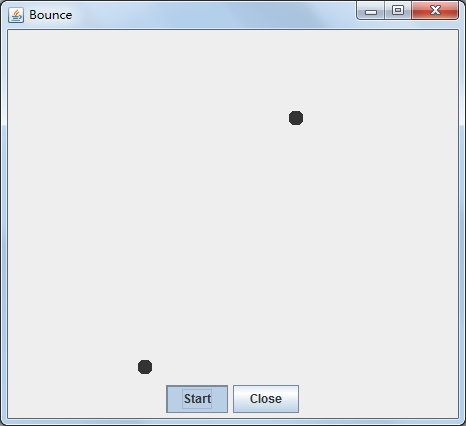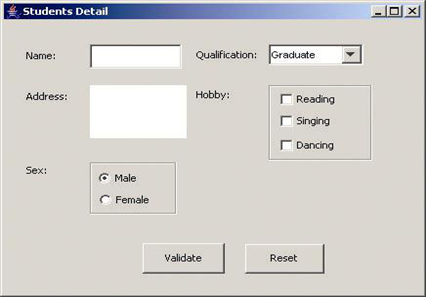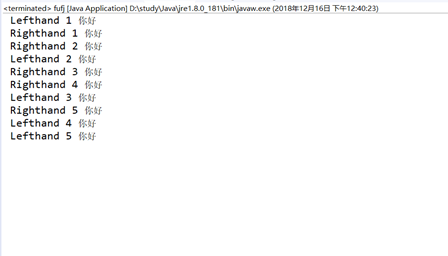第一部分:理论知识学习部分
第14章 并发
⚫ 线程的概念
⚫ 中断线程
⚫ 线程状态
⚫ 多线程调度
⚫ 线程同步
1.程序与进程的概念
1.1程序是一段静态的代码,它是应用程序执行的蓝 本。
1.2进程是程序的一次动态执行,它对应了从代码加载、执行至执行完毕的一个完整过程。
1.3操作系统为每个进程分配一段独立的内存空间和系统资源,包括:代码数据以及堆栈等资源。每一个进程的内部数据和状态都是完全独立的。
1.4多任务操作系统中,进程切换对CPU资源消耗较大。
2.多线程的概念
2.1多线程是进程执行过程中产生的多条执行线索。
2.2线程是比进程执行更小的单位。
2.3线程不能独立存在,必须存在于进程中,同一进 程的各线程间共享进程空间的数据。
2.4每个线程有它自身的产生、存在和消亡的过程, 是一个动态的概念。
2.5多线程意味着一个程序的多行语句可以看上去几 乎在同一时间内同时运行。
2.6线程创建、销毁和切换的负荷远小于进程,又称为轻量级进程(lightweight process)。
2.7Java实现多线程有两种途径:
2.7.1创建Thread类的子类
2.7.2在程序中定义实现Runnable接口的类
3.线程的终止
3.1 当线程的run方法执行方法体中最后一条语句后, 或者出现了在run方法中没有捕获的异常时,线 程将终止,让出CPU使用权。
3.2调用interrupt()方法也可终止线程。 void interrupt() –
3.2.1向一个线程发送一个中断请求,同时把这个线 程的“interrupted”状态置为true。
3.2.2若该线程处于blocked 状态, 会抛出 InterruptedException。
4.测试线程是否被中断的方法
Java提供了几个用于测试线程是否被中断的方法。
⚫ static boolean interrupted() – 检测当前线程是否已被中断, 并重置状态 “interrupted”值为false。
⚫ boolean isInterrupted() – 检测当前线程是否已被中断, 不改变状态 “interrupted”值 。
5.线程的状态
⚫ 利用各线程的状态变换,可以控制各个线程轮流 使用CPU,体现多线程的并行性特征。
⚫ 线程有如下7种状态: ➢New (新建) ➢Runnable (可运行) ➢Running(运行) ➢Blocked (被阻塞) ➢Waiting (等待) ➢Timed waiting (计时等待) ➢Terminated (被终止)
6.守护线程
⚫ 守护线程的惟一用途是为其他线程提供服务。例 如计时线程。
⚫ 若JVM的运行任务只剩下守护线程时,JVM就退 出了。
⚫ 在一个线程启动之前,调用setDaemon方法可 将线程转换为守护线程(daemon thread)。
例如: setDaemon(true);
第二部分:实验部分——线程技术
实验时间 2017-12-8
1、实验目的与要求
(1) 掌握线程概念;
(2) 掌握线程创建的两种技术;
(3) 理解和掌握线程的优先级属性及调度方法;
(4) 掌握线程同步的概念及实现技术;
2、实验内容和步骤
实验1:测试程序并进行代码注释。
测试程序1:
1.在elipse IDE中调试运行ThreadTest,结合程序运行结果理解程序;
2.掌握线程概念;
3.掌握用Thread的扩展类实现线程的方法;
4.利用Runnable接口改造程序,掌握用Runnable接口创建线程的方法。
1 class Lefthand extends Thread { 2 public void run() 3 { 4 for(int i=0;i<=5;i++) 5 { System.out.println("You are Students!"); 6 try{ sleep(500); } 7 catch(InterruptedException e) 8 { System.out.println("Lefthand error.");} 9 } 10 } 11 } 12 class Righthand extends Thread { 13 public void run() 14 { 15 for(int i=0;i<=5;i++) 16 { System.out.println("I am a Teacher!"); 17 try{ sleep(300); } 18 catch(InterruptedException e) 19 { System.out.println("Righthand error.");} 20 } 21 } 22 } 23 public class ThreadTest { 24 static Lefthand left; 25 static Righthand right; 26 27 28 public static void main(String[] args) 29 { left=new Lefthand(); 30 right=new Righthand(); 31 left.start(); 32 right.start(); 33 } 34 }
改:
1 class Lefthand implements Runnable { 2 public void run() 3 { 4 for(int i=0;i<=5;i++) 5 { System.out.println("You are Students!"); 6 try{ Thread.sleep(500); } 7 catch(InterruptedException e) 8 { System.out.println("Lefthand error.");} 9 } 10 } 11 } 12 class Righthand implements Runnable { 13 public void run() 14 { 15 for(int i=0;i<=5;i++) 16 { System.out.println("I am a Teacher!"); 17 try{ Thread.sleep(300); } 18 catch(InterruptedException e) 19 { System.out.println("Righthand error.");} 20 } 21 } 22 } 23 24 public class fufj { 25 26 static Thread left; 27 static Thread right; 28 29 public static void main(String[] args) 30 { 31 Runnable rleft = new Lefthand(); 32 Runnable rright = new Righthand(); 33 left = new Thread(rleft); 34 right = new Thread(rright); 35 left.start(); 36 right.start(); 37 } 38 39 } 40
测试程序2:
1.在Elipse环境下调试教材625页程序14-1、14-2 、14-3,结合程序运行结果理解程序;
2.在Elipse环境下调试教材631页程序14-4,结合程序运行结果理解程序;
3.对比两个程序,理解线程的概念和用途;
4.掌握线程创建的两种技术。

1 package bounce; 2 3 import java.awt.geom.*; 4 5 /** 6 * 弹球从矩形的边缘上移动和弹出的球 7 * @version 1.33 2007-05-17 8 * @author Cay Horstmann 9 */ 10 public class Ball 11 { 12 private static final int XSIZE = 15; 13 private static final int YSIZE = 15; 14 private double x = 0; 15 private double y = 0; 16 private double dx = 1; 17 private double dy = 1; 18 19 /** 20 * 将球移动到下一个位置,如果球击中一个边缘,则向相反的方向移动。 21 */ 22 public void move(Rectangle2D bounds) 23 { 24 x += dx; 25 y += dy; 26 if (x < bounds.getMinX()) 27 { 28 x = bounds.getMinX(); 29 dx = -dx; 30 } 31 if (x + XSIZE >= bounds.getMaxX()) 32 { 33 x = bounds.getMaxX() - XSIZE; 34 dx = -dx; 35 } 36 if (y < bounds.getMinY()) 37 { 38 y = bounds.getMinY(); 39 dy = -dy; 40 } 41 if (y + YSIZE >= bounds.getMaxY()) 42 { 43 y = bounds.getMaxY() - YSIZE; 44 dy = -dy; 45 } 46 } 47 48 /** 49 * 获取当前位置的球的形状。 50 */ 51 public Ellipse2D getShape() 52 { 53 return new Ellipse2D.Double(x, y, XSIZE, YSIZE); 54 } 55 }

1 package bounce; 2 3 import java.awt.*; 4 import java.util.*; 5 import javax.swing.*; 6 7 /** 8 * 拉球的部件。 9 * @version 1.34 2012-01-26 10 * @author Cay Horstmann 11 */ 12 public class BallComponent extends JPanel 13 { 14 private static final int DEFAULT_WIDTH = 450; 15 private static final int DEFAULT_HEIGHT = 350; 16 17 private java.util.List<Ball> balls = new ArrayList<>(); 18 19 /** 20 * 向组件中添加一个球。 21 * @param b要添加的球 22 */ 23 public void add(Ball b) 24 { 25 balls.add(b); 26 } 27 28 public void paintComponent(Graphics g) 29 { 30 super.paintComponent(g); // 擦除背景 31 Graphics2D g2 = (Graphics2D) g; 32 for (Ball b : balls) 33 { 34 g2.fill(b.getShape()); 35 } 36 } 37 38 public Dimension getPreferredSize() { return new Dimension(DEFAULT_WIDTH, DEFAULT_HEIGHT); } 39 }

1 package bounce; 2 3 import java.awt.*; 4 import java.awt.event.*; 5 import javax.swing.*; 6 7 /** 8 * 显示一个动画弹跳球。 9 * @version 1.34 2015-06-21 10 * @author Cay Horstmann 11 */ 12 public class Bounce 13 { 14 public static void main(String[] args) 15 { 16 EventQueue.invokeLater(() -> { 17 JFrame frame = new BounceFrame(); 18 frame.setDefaultCloseOperation(JFrame.EXIT_ON_CLOSE); 19 frame.setVisible(true); 20 }); 21 } 22 } 23 24 /** 25 * 框架与球组件和按钮。 26 */ 27 class BounceFrame extends JFrame 28 { 29 private BallComponent comp; 30 public static final int STEPS = 1000; 31 public static final int DELAY = 3; 32 33 /** 34 * 用显示弹跳球的组件构造框架,以及开始和关闭按钮 35 */ 36 public BounceFrame() 37 { 38 setTitle("Bounce"); 39 comp = new BallComponent(); 40 add(comp, BorderLayout.CENTER); 41 JPanel buttonPanel = new JPanel(); 42 addButton(buttonPanel, "Start", event -> addBall()); 43 addButton(buttonPanel, "Close", event -> System.exit(0)); 44 add(buttonPanel, BorderLayout.SOUTH); 45 pack(); 46 } 47 48 /** 49 * 向容器添加按钮。 50 * @param c容器 51 * @param title 按钮标题 52 * @param 监听按钮的操作监听器 53 */ 54 public void addButton(Container c, String title, ActionListener listener) 55 { 56 JButton button = new JButton(title); 57 c.add(button); 58 button.addActionListener(listener); 59 } 60 61 /** 62 * 在面板上添加一个弹跳球,使其弹跳1000次。 63 */ 64 public void addBall() 65 { 66 try 67 { 68 Ball ball = new Ball(); 69 comp.add(ball); 70 71 for (int i = 1; i <= STEPS; i++) 72 { 73 ball.move(comp.getBounds()); 74 comp.paint(comp.getGraphics()); 75 Thread.sleep(DELAY); 76 } 77 } 78 catch (InterruptedException e) 79 { 80 } 81 } 82 }


1 package bounceThread; 2 3 import java.awt.geom.*; 4 5 /** 6 弹球从矩形的边缘上移动和弹出的球 7 * @version 1.33 2007-05-17 8 * @author Cay Horstmann 9 */ 10 public class Ball 11 { 12 private static final int XSIZE = 15; 13 private static final int YSIZE = 15; 14 private double x = 0; 15 private double y = 0; 16 private double dx = 1; 17 private double dy = 1; 18 19 /** 20 将球移动到下一个位置,如果球击中一个边缘,则向相反的方向移动。 21 */ 22 public void move(Rectangle2D bounds) 23 { 24 x += dx; 25 y += dy; 26 if (x < bounds.getMinX()) 27 { 28 x = bounds.getMinX(); 29 dx = -dx; 30 } 31 if (x + XSIZE >= bounds.getMaxX()) 32 { 33 x = bounds.getMaxX() - XSIZE; 34 dx = -dx; 35 } 36 if (y < bounds.getMinY()) 37 { 38 y = bounds.getMinY(); 39 dy = -dy; 40 } 41 if (y + YSIZE >= bounds.getMaxY()) 42 { 43 y = bounds.getMaxY() - YSIZE; 44 dy = -dy; 45 } 46 } 47 48 /** 49 获取当前位置的球的形状。 50 */ 51 public Ellipse2D getShape() 52 { 53 return new Ellipse2D.Double(x, y, XSIZE, YSIZE); 54 } 55 }

1 package bounceThread; 2 3 import java.awt.*; 4 import java.util.*; 5 import javax.swing.*; 6 7 /** 8 * 拉球的部件。 9 * @version 1.34 2012-01-26 10 * @author Cay Horstmann 11 */ 12 public class BallComponent extends JComponent 13 { 14 private static final int DEFAULT_WIDTH = 450; 15 private static final int DEFAULT_HEIGHT = 350; 16 17 private java.util.List<Ball> balls = new ArrayList<>(); 18 19 /** 20 * 在面板上添加一个球。 21 * @param b要添加的球 22 */ 23 public void add(Ball b) 24 { 25 balls.add(b); 26 } 27 28 public void paintComponent(Graphics g) 29 { 30 Graphics2D g2 = (Graphics2D) g; 31 for (Ball b : balls) 32 { 33 g2.fill(b.getShape()); 34 } 35 } 36 37 public Dimension getPreferredSize() { return new Dimension(DEFAULT_WIDTH, DEFAULT_HEIGHT); } 38 }

1 package bounceThread; 2 3 import java.awt.*; 4 import java.awt.event.*; 5 6 import javax.swing.*; 7 8 /** 9 * 显示动画弹跳球。 10 * @version 1.34 2015-06-21 11 * @author Cay Horstmann 12 */ 13 public class BounceThread 14 { 15 public static void main(String[] args) 16 { 17 EventQueue.invokeLater(() -> { 18 JFrame frame = new BounceFrame(); 19 frame.setTitle("BounceThread"); 20 frame.setDefaultCloseOperation(JFrame.EXIT_ON_CLOSE); 21 frame.setVisible(true); 22 }); 23 } 24 } 25 26 /** 27 * 带有面板和按钮的框架。 28 */ 29 class BounceFrame extends JFrame 30 { 31 private BallComponent comp; 32 public static final int STEPS = 1000; 33 public static final int DELAY = 5; 34 35 36 /** 37 * 用显示弹跳球以及开始和关闭按钮的组件构建框架 38 */ 39 public BounceFrame() 40 { 41 comp = new BallComponent(); 42 add(comp, BorderLayout.CENTER); 43 JPanel buttonPanel = new JPanel(); 44 addButton(buttonPanel, "Start", event -> addBall()); 45 addButton(buttonPanel, "Close", event -> System.exit(0)); 46 add(buttonPanel, BorderLayout.SOUTH); 47 pack(); 48 } 49 50 /** 51 * 向容器添加按钮。 52 * @param c 容器 53 * @param title 按钮标题 54 * @param listener 按钮的操作监听器 55 */ 56 public void addButton(Container c, String title, ActionListener listener) 57 { 58 JButton button = new JButton(title); 59 c.add(button); 60 button.addActionListener(listener); 61 } 62 63 /** 64 * 在画布上添加一个弹跳球,并启动一个线程使其弹跳 65 */ 66 public void addBall() 67 { 68 Ball ball = new Ball(); 69 comp.add(ball); 70 Runnable r = () -> { 71 try 72 { 73 for (int i = 1; i <= STEPS; i++) 74 { 75 ball.move(comp.getBounds()); 76 comp.repaint(); 77 Thread.sleep(DELAY); 78 } 79 } 80 catch (InterruptedException e) 81 { 82 } 83 }; 84 Thread t = new Thread(r); 85 t.start(); 86 } 87 }
测试程序3:分析以下程序运行结果并理解程序。
1 class Race extends Thread { 2 public static void main(String args[]) { 3 Race[] runner=new Race[4]; 4 for(int i=0;i<4;i++) runner[i]=new Race( ); 5 for(int i=0;i<4;i++) runner[i].start( ); 6 runner[1].setPriority(MIN_PRIORITY); 7 runner[3].setPriority(MAX_PRIORITY);} 8 public void run( ) { 9 for(int i=0; i<1000000; i++); 10 System.out.println(getName()+"线程的优先级是"+getPriority()+"已计算完毕!"); 11 } 12 }
测试代码
1 package vb; 2 3 public class asd { 4 static class Race extends Thread { 5 public static void main(String[] args) { 6 Race[] runner=new Race[4]; 7 for(int i=0;i<4;i++) runner[i]=new Race( ); 8 for(int i=0;i<4;i++) runner[i].start( ); 9 runner[1].setPriority(MIN_PRIORITY); 10 runner[3].setPriority(MAX_PRIORITY);} 11 public void run( ) { 12 for(int i=0; i<1000000; i++);//延时作用 13 System.out.println(getName()+"线程的优先级是"+getPriority()+"已计算完毕!"); 14 } 15 } 16 17 }

测试程序4
1.教材642页程序模拟一个有若干账户的银行,随机地生成在这些账户之间转移钱款的交易。每一个账户有一个线程。在每一笔交易中,会从线程所服务的账户中随机转移一定数目的钱款到另一个随机账户。
2.在Elipse环境下调试教材642页程序14-5、14-6,结合程序运行结果理解程序;

1 package unsynch; 2 3 import java.util.*; 4 5 /** 6 * 有许多银行账户的银行。 7 * @version 1.30 2004-08-01 8 * @author Cay Horstmann 9 */ 10 public class Bank 11 { 12 private final double[] accounts; 13 14 /** 15 * 建设银行。 16 * @param n 账号 17 * @param initialBalance 每个账户的初始余额 18 */ 19 public Bank(int n, double initialBalance) 20 { 21 accounts = new double[n]; 22 Arrays.fill(accounts, initialBalance); 23 } 24 25 /** 26 * 把钱从一个账户转到另一个账户。 27 * @param from 转账账户 28 * @param to 转账账户 29 * @param amount 转账金额 30 */ 31 public void transfer(int from, int to, double amount) 32 { 33 if (accounts[from] < amount) return; 34 System.out.print(Thread.currentThread()); 35 accounts[from] -= amount; 36 System.out.printf(" %10.2f from %d to %d", amount, from, to); 37 accounts[to] += amount; 38 System.out.printf(" Total Balance: %10.2f%n", getTotalBalance()); 39 } 40 41 /** 42 * 获取所有帐户余额的总和。 43 * @return 总余额 44 */ 45 public double getTotalBalance() 46 { 47 double sum = 0; 48 49 for (double a : accounts) 50 sum += a; 51 52 return sum; 53 } 54 55 /** 56 * 获取银行中的帐户数量。 57 * @return 账号 58 */ 59 public int size() 60 { 61 return accounts.length; 62 } 63 }

1 package unsynch; 2 3 /** 4 * 此程序显示多个线程访问数据结构时的数据损坏。 5 * @version 1.31 2015-06-21 6 * @author Cay Horstmann 7 */ 8 public class UnsynchBankTest 9 { 10 public static final int NACCOUNTS = 100; 11 public static final double INITIAL_BALANCE = 1000; 12 public static final double MAX_AMOUNT = 1000; 13 public static final int DELAY = 10; 14 15 public static void main(String[] args) 16 { 17 Bank bank = new Bank(NACCOUNTS, INITIAL_BALANCE); 18 for (int i = 0; i < NACCOUNTS; i++) 19 { 20 int fromAccount = i; 21 Runnable r = () -> { 22 try 23 { 24 while (true) 25 { 26 int toAccount = (int) (bank.size() * Math.random()); 27 double amount = MAX_AMOUNT * Math.random(); 28 bank.transfer(fromAccount, toAccount, amount); 29 Thread.sleep((int) (DELAY * Math.random())); 30 } 31 } 32 catch (InterruptedException e) 33 { 34 } 35 }; 36 Thread t = new Thread(r); 37 t.start(); 38 } 39 } 40 }

综合编程练习
编程练习1
1.设计一个用户信息采集程序,要求如下:
(1) 用户信息输入界面如下图所示:

(2) 用户点击提交按钮时,用户输入信息显示控制台界面;
(3) 用户点击重置按钮后,清空用户已输入信息;
(4) 点击窗口关闭,程序退出。

1 package 程序一; 2 3 import java.awt.EventQueue; 4 5 import javax.swing.JFrame; 6 7 public class First_exercise { 8 public static void main(String[] args) { 9 EventQueue.invokeLater(() -> { 10 DemoJFrame JFrame = new DemoJFrame(); 11 }); 12 } 13 }

1 package 程序一; 2 3 4 import java.awt.Color; 5 import java.awt.Dimension; 6 import java.awt.FlowLayout; 7 import java.awt.GridLayout; 8 import java.awt.LayoutManager; 9 import java.awt.Panel; 10 import java.awt.event.ActionEvent; 11 import java.awt.event.ActionListener; 12 13 import java.io.BufferedReader; 14 import java.io.File; 15 import java.io.FileInputStream; 16 import java.io.IOException; 17 import java.io.InputStreamReader; 18 19 import java.util.ArrayList; 20 import java.util.Timer; 21 import java.util.TimerTask; 22 23 import javax.swing.BorderFactory; 24 import javax.swing.ButtonGroup; 25 import javax.swing.ButtonModel; 26 import javax.swing.JButton; 27 import javax.swing.JCheckBox; 28 import javax.swing.JComboBox; 29 import javax.swing.JFrame; 30 import javax.swing.JLabel; 31 import javax.swing.JPanel; 32 import javax.swing.JRadioButton; 33 import javax.swing.JTextField; 34 35 public class DemoJFrame extends JFrame { 36 private JPanel jPanel1; 37 private JPanel jPanel2; 38 private JPanel jPanel3; 39 private JPanel jPanel4; 40 private JTextField fieldname; 41 private JComboBox comboBox; 42 private JTextField fieldadress; 43 private ButtonGroup Button; 44 private JRadioButton Male; 45 private JRadioButton Female; 46 private JCheckBox sing; 47 private JCheckBox dance; 48 private JCheckBox draw; 49 50 public DemoJFrame() { 51 this.setSize(750, 450); 52 this.setVisible(true); 53 this.setTitle("Student Detail"); 54 this.setDefaultCloseOperation(EXIT_ON_CLOSE); 55 Windows.center(this); 56 jPanel1 = new JPanel(); 57 setJPanel1(jPanel1); 58 jPanel2 = new JPanel(); 59 setJPanel2(jPanel2); 60 jPanel3 = new JPanel(); 61 setJPanel3(jPanel3); 62 jPanel4 = new JPanel(); 63 setJPanel4(jPanel4); 64 FlowLayout flowLayout = new FlowLayout(); 65 this.setLayout(flowLayout); 66 this.add(jPanel1); 67 this.add(jPanel2); 68 this.add(jPanel3); 69 this.add(jPanel4); 70 71 } 72 73 private void setJPanel1(JPanel jPanel) { 74 jPanel.setPreferredSize(new Dimension(700, 45)); 75 jPanel.setLayout(new GridLayout(1, 4)); 76 JLabel name = new JLabel("Name:"); 77 name.setSize(100, 50); 78 fieldname = new JTextField(""); 79 fieldname.setSize(80, 20); 80 JLabel study = new JLabel("Qualification:"); 81 comboBox = new JComboBox(); 82 comboBox.addItem("Graduate"); 83 comboBox.addItem("senior"); 84 comboBox.addItem("Undergraduate"); 85 jPanel.add(name); 86 jPanel.add(fieldname); 87 jPanel.add(study); 88 jPanel.add(comboBox); 89 90 } 91 92 private void setJPanel2(JPanel jPanel) { 93 jPanel.setPreferredSize(new Dimension(700, 50)); 94 jPanel.setLayout(new GridLayout(1, 4)); 95 JLabel name = new JLabel("Address:"); 96 fieldadress = new JTextField(); 97 fieldadress.setPreferredSize(new Dimension(150, 50)); 98 JLabel study = new JLabel("Hobby:"); 99 JPanel selectBox = new JPanel(); 100 selectBox.setBorder(BorderFactory.createTitledBorder("")); 101 selectBox.setLayout(new GridLayout(3, 1)); 102 sing = new JCheckBox("Singing"); 103 dance = new JCheckBox("Dancing"); 104 draw = new JCheckBox("Reading"); 105 selectBox.add(sing); 106 selectBox.add(dance); 107 selectBox.add(draw); 108 jPanel.add(name); 109 jPanel.add(fieldadress); 110 jPanel.add(study); 111 jPanel.add(selectBox); 112 } 113 114 private void setJPanel3(JPanel jPanel) { 115 jPanel.setPreferredSize(new Dimension(700, 150)); 116 FlowLayout flowLayout = new FlowLayout(FlowLayout.LEFT); 117 jPanel.setLayout(flowLayout); 118 JLabel sex = new JLabel("Sex:"); 119 JPanel selectBox = new JPanel(); 120 selectBox.setBorder(BorderFactory.createTitledBorder("")); 121 selectBox.setLayout(new GridLayout(2, 1)); 122 Button = new ButtonGroup(); 123 Male = new JRadioButton("Male"); 124 Female = new JRadioButton("Female"); 125 Button.add(Male); 126 Button.add(Female); 127 selectBox.add(Male); 128 selectBox.add(Female); 129 jPanel.add(sex); 130 jPanel.add(selectBox); 131 132 } 133 134 private void setJPanel4(JPanel jPanel) { 135 // TODO 自动生成的方法存根 136 jPanel.setPreferredSize(new Dimension(700, 150)); 137 FlowLayout flowLayout = new FlowLayout(FlowLayout.CENTER, 50, 10); 138 jPanel.setLayout(flowLayout); 139 jPanel.setLayout(flowLayout); 140 JButton sublite = new JButton("Validate"); 141 JButton reset = new JButton("Reset"); 142 sublite.addActionListener((e) -> valiData()); 143 reset.addActionListener((e) -> Reset()); 144 jPanel.add(sublite); 145 jPanel.add(reset); 146 } 147 148 private void valiData() { 149 String name = fieldname.getText().toString().trim(); 150 String xueli = comboBox.getSelectedItem().toString().trim(); 151 String address = fieldadress.getText().toString().trim(); 152 System.out.println(name); 153 System.out.println(xueli); 154 String hobbystring=""; 155 if (sing.isSelected()) { 156 hobbystring+="Singing "; 157 } 158 if (dance.isSelected()) { 159 hobbystring+="Dancing "; 160 } 161 if (draw.isSelected()) { 162 hobbystring+="Reading "; 163 } 164 System.out.println(address); 165 if (Male.isSelected()) { 166 System.out.println("Male"); 167 } 168 if (Female.isSelected()) { 169 System.out.println("Female"); 170 } 171 System.out.println(hobbystring); 172 } 173 174 private void Reset() { 175 fieldadress.setText(null); 176 fieldname.setText(null); 177 comboBox.setSelectedIndex(0); 178 sing.setSelected(false); 179 dance.setSelected(false); 180 draw.setSelected(false); 181 Button.clearSelection(); 182 } 183 }

1 package 程序一; 2 3 4 import java.awt.Dimension; 5 import java.awt.Toolkit; 6 import java.awt.Window; 7 8 public class Windows { 9 public static void center(Window win){ 10 Toolkit tkit = Toolkit.getDefaultToolkit(); 11 Dimension sSize = tkit.getScreenSize(); 12 Dimension wSize = win.getSize(); 13 14 if(wSize.height > sSize.height){ 15 wSize.height = sSize.height; 16 } 17 18 if(wSize.width > sSize.width){ 19 wSize.width = sSize.width; 20 } 21 22 win.setLocation((sSize.width - wSize.width)/ 2, (sSize.height - wSize.height)/ 2); 23 } 24 }

2.创建两个线程,每个线程按顺序输出5次“你好”,每个“你好”要标明来自哪个线程及其顺序号。

1 package 程序二; 2 3 class Lefthand implements Runnable { 4 public void run(){ 5 for(int i=1;i<=5;i++) 6 { System.out.println(" Lefthand "+i+" 你好"); 7 try{ Thread.sleep(500); } 8 catch(InterruptedException e) 9 { System.out.println("Lefthand error.");} 10 } 11 } 12 } 13 class Righthand implements Runnable { 14 public void run(){ 15 for(int i=1;i<=5;i++) 16 { System.out.println(" Righthand "+i+" 你好"); 17 try{ Thread.sleep(300); } 18 catch(InterruptedException e) 19 { System.out.println("Righthand error.");} 20 } 21 } 22 } 23 24 public class Second_exercise { 25 26 static Thread left; 27 static Thread right; 28 29 public static void main(String[] args){ 30 Runnable rleft = new Lefthand(); 31 Runnable rright = new Righthand(); 32 left = new Thread(rleft); 33 right = new Thread(rright); 34 left.start(); 35 right.start(); 36 } 37 38 }

3. 完善实验十五 GUI综合编程练习程序。
第三部分:总结
通过本周的学习,我掌握了线程概念;线程创建的两种技术;理解和掌握了基础线程的优先级属性及调度方法;学会了Java GUI 编程技术的基础。因为要考四级所以学习时间有所减少,这部分学习不是很扎实,在以后的学习中会继续巩固学习。
